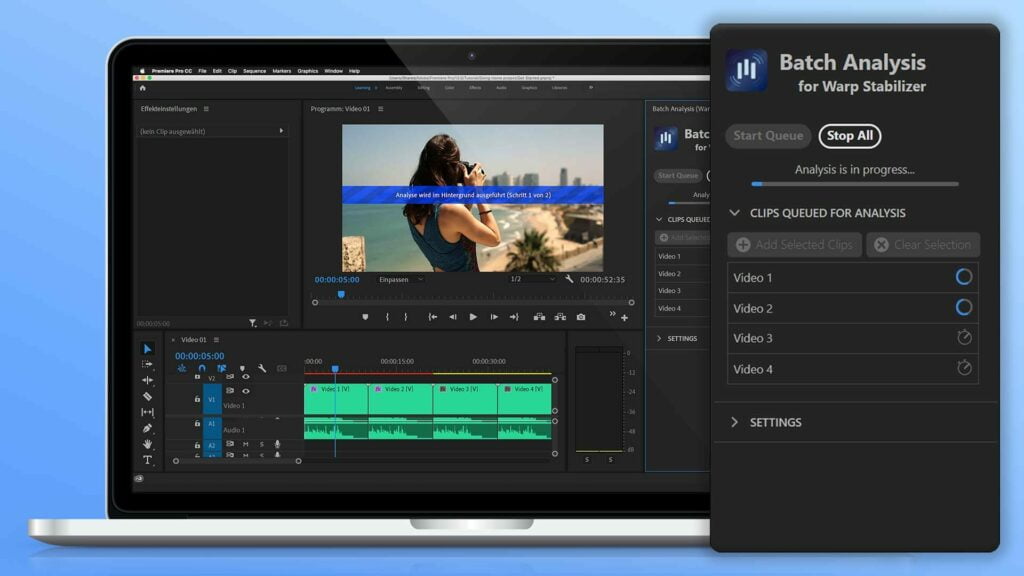Combining Proxies and Warp Stabilizer in Adobe Premiere Pro
Proxies are a powerful tool in Premiere Pro to work smoothly with high-resolution footage, even on less powerful hardware. However, there are specific Premiere Pro effects that disregard proxies, such as the Warp Stabilizer, Rolling Shutter Repair, and Morph Cut. When one of these effects is applied to a clip, Premiere Pro utilizes and displays the full resolution footage, regardless of the Toggle/Enable Proxies setting. This complicates working with these effects on demanding footage.
Due to this limitation, certain workarounds are needed to smoothly work with proxies and effects, like the Warp Stabilizer in Premiere Pro. Below, you can find different approaches to solving this:
Approach 1: Analyzing Proxies, Working with Offline Full-Resolution Footage
There is one exception where Premiere Pro utilizes proxies even with an effect like the Warp Stabilizer applied: when the full-resolution footage is offline but the proxy files are online, the proxy files are used. The initial thought might be to set the full-resolution footage offline and work with proxies, toggling the original footage online again before exporting. While this seems straightforward, this workflow is not recommended. Analyzing the low-resolution clips also utilizes low-resolution analysis data for the full-resolution clips, potentially resulting in lower quality stabilization.
Approach 2: Working with offline full-resolution footage, after performing analysis
An easy mitigation for the issues in the above approach is analyzing the full resolution, then toggling proxies and using the proxies for playback. However, this approach also has disadvantages: For one, the analysis data of the high-resolution footage requires more computational power and could lead to stutters during playback. It will also require significant analysis time and increase the project file size at an early stage of the project. For others, results may differ, giving editors a false impression of stabilization. Also, when modifying the clips, Premiere Pro may perform re-analysis, which will now create low quality analysis data.
Approach 3 (RECOMMENDED): Analyzing Proxies, Automatic Re-Analysis
This approach will give you the maximum quality while providing the smoothest playback. Set the full-resolution footage offline before analyzing it, and apply the Warp Stabilizer (or any other analysis effect) to the proxy. Analysis will be performed on the proxy. Then, before export, toggle the original footage to set it online again and perform a re-analysis on the full-resolution footage. To minimize manual steps, utilize an extension such as the Batch Analysis Extension to automatically reanalyze all clips in your timeline.This extension allows you to automatically analyze all clips that require analysis. Additionally, you can use it to automatically apply effects to new footage, especially when working with a large number of clips.

Batch Analysis for Warp Stabilizer
Use the Batch Stabilization extension in Adobe Premiere Pro to quickly stabilize a larger number of clips. Get smooth, professional-looking footage in a few clicks.
Step-By-Step
How to Combine Proxies and Warp Stabilizer
- Create Proxies
Import your high-resolution video files into Premiere Pro. Right-click on the footage in the Project panel and select Proxy > Create Proxies. Choose a preset that matches your needs.
- Toggle Footage Offline
Locate the media files in the project panel. Right-click on the media files you want to set offline. Select “Make Offline” from the contextual menu.
- Apply Warp Stabilizer
Apply the Warp Stabilizer effect. Tip: If you stabilize several clips at once, use the Batch Analysis Extension.
- Edit
Edit your footage as needed, and keep the original footage offline.
- Toggle Footage Online:
Locate the media files in the project panel. Right-click on the media files you want to set online. Select “Link Media” from the contextual menu.
- Re-Analyze Clips:
Use a tool like the Batch Analysis Extension to automatically re-analyze. Alternatively, reanalyze the clips manually.
Summary
Proxies are useful for smooth editing of high-resolution footage on less powerful hardware. However, some effects like Warp Stabilizer don’t utilize proxies. Three approaches can mitigate this:
- Recommended Approach: Set full-resolution footage offline for analysis, apply the effect to the proxy, then toggle footage online for re-analysis before export.
- Alternative 1: Analyzing Proxies, Working with Offline Full-Resolution Footage: Full-resolution offline, proxy online, but may result in lower quality stabilization.
- Alternative 2: Working with Offline Full-Resolution Footage After Analysis: Analyze full resolution, then toggle proxies for playback, but may lead to stuttering and increased project size.
FAQ: Premiere Pro Proxies
Effects such as Warp Stabilizer, Rolling Shutter Repair, and Morph Cut ignore proxy files and use the full-resolution footage. This can complicate the workflow, when dealing with complex footage.
Yes, you can use the Warp Stabilizer effect to analyze proxies rather than the high-resolution footage. For smoother playback and effective stabilization, set the full- resolution footage offline prior to analysis and apply the effect to the proxies. Analysis performed on the proxies can lead to lower-quality stabilization. Extensions like the Batch Analysis Extension can help you ensure maximum quality before exporting the final project.
To automate the re-analysis in Premiere Pro, you can utilize extensions such as the Batch Analysis Extension. This tool allows you to automatically re-analyze clips in your timeline.
The recommended approach is to analyze proxies, perform automatic re-analysis, and toggle the full-resolution footage online before exporting. This ensures smooth playback while maintaining maximum quality. Extensions such as the Batch Analysis Extension can assist you in avoiding manual steps.
Yes. Analyzing proxies instead of full-resolution footage can result in lower quality stabilization due to the use of low-resolution analysis data. It is important to toggle the full-resolution footage online before exporting to ensure optimal quality. Re-analysis of clips can also lead to better quality. Tools like the Batch Analysis Extension can help with this process.
